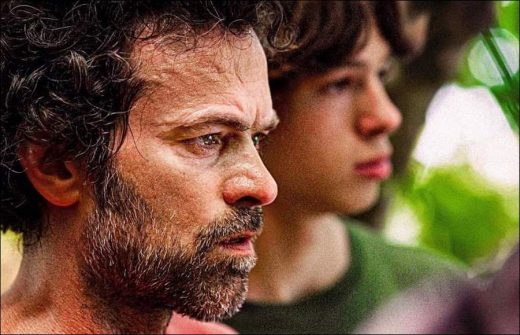The Animal Kingdom; Evolution and revolutions. The director is inspired by Thomas Cailley’s camera, we cannot know whether the Covid epidemic was the exact inspiration. However, it is certain that it puts an end to all the zombie and bloodsucking Count Dracula stories ever shot… “The Animal Kingdom”, which aims to look at the human being that has lost itself from its essence and does not respect anyone but itself, was included in the archives.
“The Animal Kingdom”, the opening film of the “Un Certain Regard” section of the Cannes Film Festival, summarizes the evolution of humanity with a general evaluation in 130 minutes. It tells us that all of humanity has reached the point of extinction and has evolved into loneliness by consuming itself. Let’s remember a movie frame from the movie Joker.
Inside the car in congested traffic, there were ultimatums, rule-making and self-control efforts of a father trying to get his son to his destination. After getting angry at the chips his son ate and saying “I’m not a system person”, he lights a cigarette and ends the sampling stages with the same shot, but what’s going on inside… In this French-Belgian co-production film called “Animal Kingdom”, there is a reflection of what the average human life does in the blink of an eye, endless invasion and self-righteousness.
If we look at the film only from this perspective, where the director touches on Cailley’s evolution process, but everyone generally interprets it as “adolescence”, we would be doing a great deal of injustice. We need to interpret the movie “Animal Kingdom” mainly in two ways. First: As I always look at from the same perspective, the director based the process of humanization, “Evolution and Revolutions”, only on the Middle Ages and the French Revolution in the movie Animal Kingdom. The summary of the age-old but fundamental issue of “remaining human” is handled in this film, minutely and one by one, like an embroidery.
No matter how much we try to explain, it will be inadequate, and especially, this masterpiece, which deserves to be kept as an archive, will perhaps make us question our humanity again in the future, when we get bored, lose the sense of gratitude, and lose the value of what we have, when it is time to watch it. Yes, the main character in the movie, Emile-Paul Kircher (when you combine it with the second part, you will be able to understand the movie better), seems to be shaped through the nudity of humanization and human raising during his journey to puberty or adolescence.
The reflection of the son as a changing character and the hormonal situations in return for the authority established by the father figure (François-Romain Duris) as the arbiter in a patriarchal order, how the pressure established by the man in the institution of marriage pushes the mother away, while a woman who lived through the French revolution still has sexual intercourse with the chains she puts on her man’s feet. The director makes us read the face of the mother, who has mutated and escaped into the forest from the hospital where she was hospitalized, the face of her life process, which is never seen except in photographs, as an object figure. But all of them are closed, all details are reserved for the interpretation of the audience.
This being the case, during the escape of the mother given in the movie and the mother of the male and adolescent boy Emile, who are referred to as monster/creature/creature as addressed to all mutated, symbolically depicted beings, the red, blue and white colors swirling in the background. It makes one think of the traces of a French Revolution that has still not been digested.
Just as Fix (Tom Mercier), who was once a one-winged man and actually his guide, sucked his own blood after the first wound he inflicted, it is conveyed as France drinking its own blood. This is how the revolution already took place and went down in history.
In the previous scene, under the mood of adolescent Emile, which is slowly starting to change; The Middle Ages and the process of women being labeled as “Witches” and being burned alive, including the analogy they made for a woman they thought was mutated and which they thought was mutated, especially by one of the girls while they were gathering with their friends, with the phrase “After Italian Lesson”, and the process of women being labeled as “Witches” and burned alive, as the film progresses. The descriptions of humanity putting all cats in a sack and burning them on the day they describe as a special day in their pictures are entirely references to medieval bigotry. In the following scenes, we see that the Inquisition courts have not changed despite the ages, and that they are trying to destroy all species except humans in the forest.
The gradual formation of the second wing of the mutated, single-winged, flightless human-animal species, which is given at the beginning of the movie and which will guide Emile’s life like a guide in the traffic scene and in the following process, is actually a reflection of Emilie’s entire adolescence and becoming a man, as well as this. He skillfully carries the adventure of liberation and becoming an individual until the end of the film.
The Animal Kingdom (2023)
Le Règne Aanimal
Directed by: Thomas Cailley
Starring: Romain Duris, Paul Kircher, Adèle Exarchopoulos, Tom Mercier, Billie Blain, Nathalie Richard, Maëlle Benkimoun, Saadia Bentaïeb, Gabriel Caballero, Iliana Khelifa, Florence Deretz
Screenplay by: Thomas Cailley, Pauline Munier
Production Design by: Julia Lemaire
Cinematography by: David Cailley
Film Editing by: Lilian Corbeille
Costume Design by: Ariane Daurat
Art Direction by: Vincent Amiel, Jules Barbier
Music by: Andrea Laszlo De Simone
MPAA Rating: None.
Distributed by: StudioCanal
Release Date: May 17, 2023 (Cannes), October 4, 2023 (France)
All about The Animal Kingdom movie.
Views: 183







